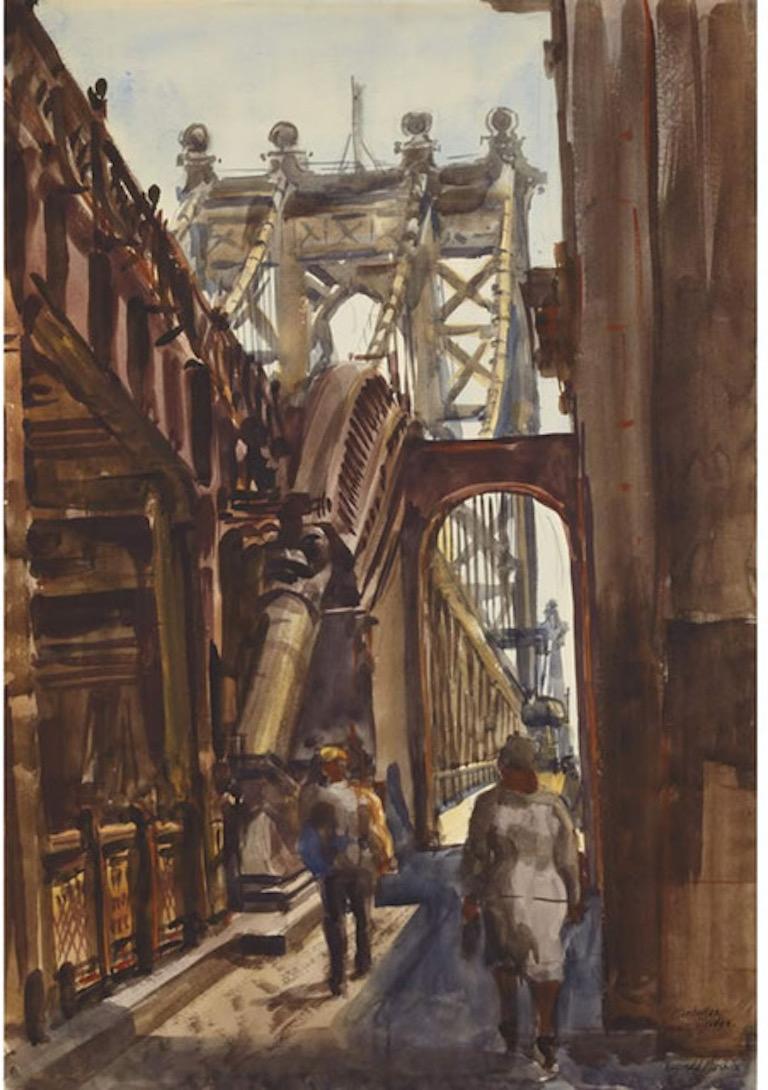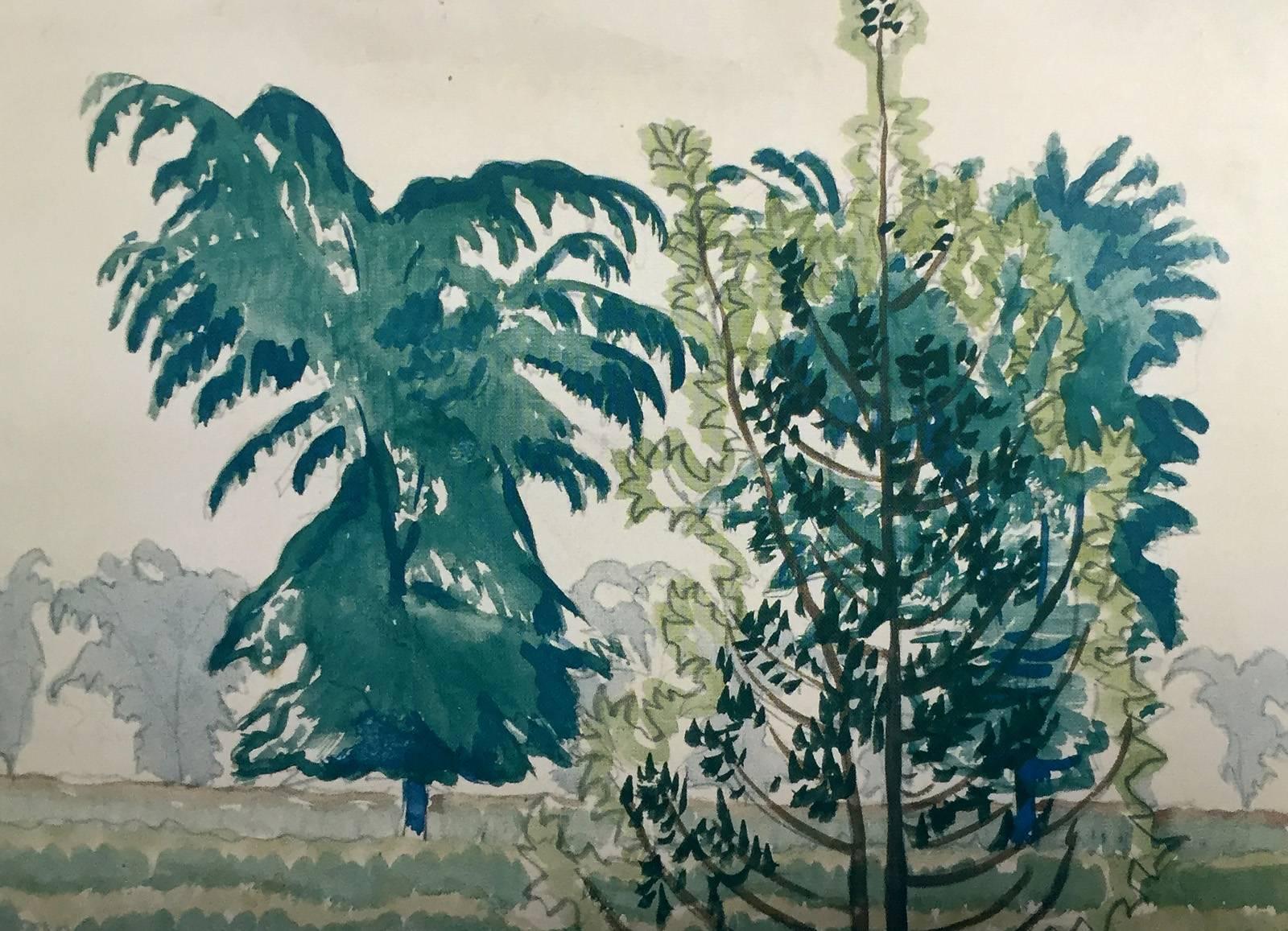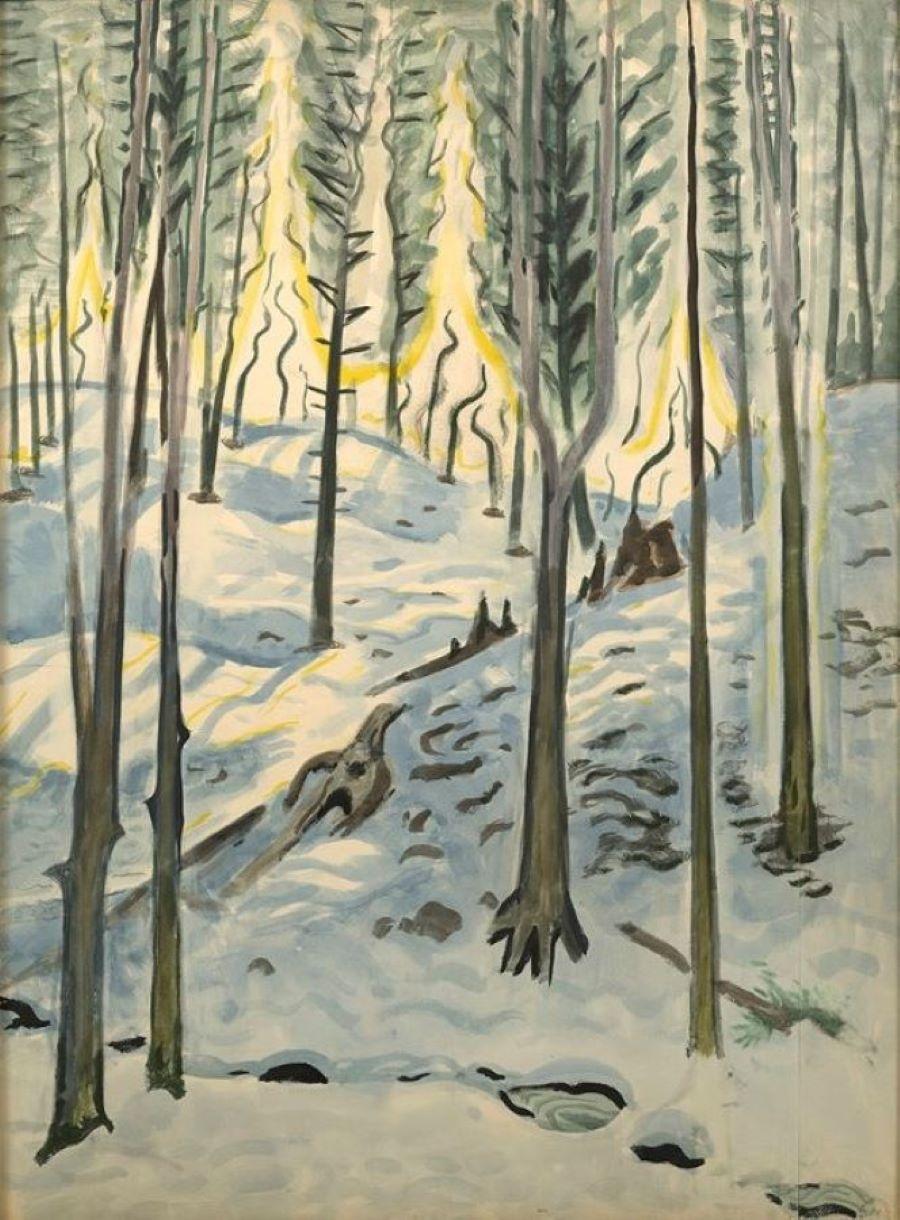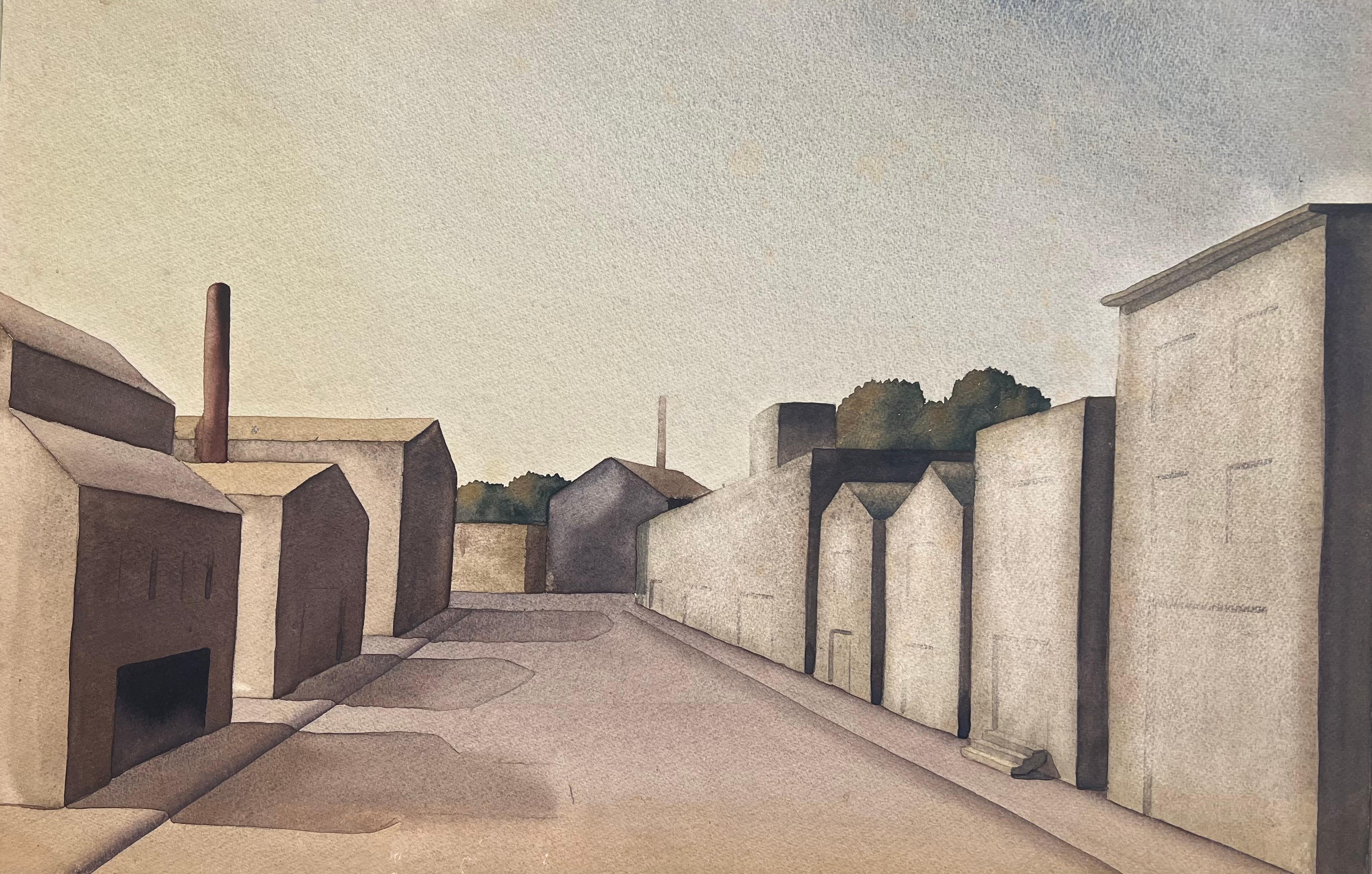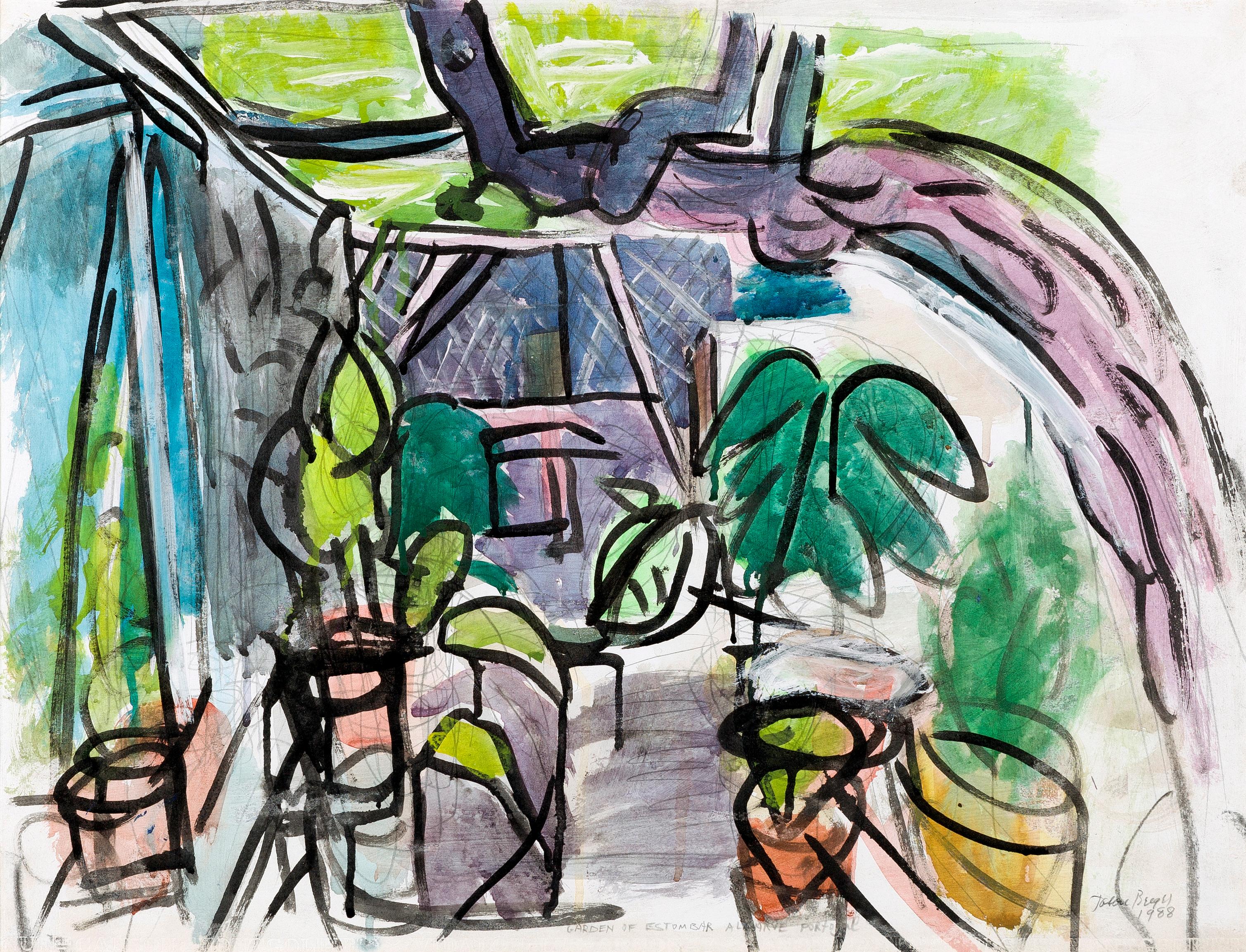Items Similar to Cows in a Field (Recto) Two Figures in an Interior (Verso)
Want more images or videos?
Request additional images or videos from the seller
1 of 14
Louis SchankerCows in a Field (Recto) Two Figures in an Interior (Verso)1938
1938
About the Item
Cows in a Field (Recto)
Two Figures in an Interior (Verso)
Watercolor on heavy textured paper, 1938
Signed in ink verso image of Two Figures, unsigned recto on watercolor
Conidition: Excellent
Image size: 15 5/8 x 20 inches
Provenance: Estate of the Artist
Susan Teller Gallery, New York (representing the estate)
Brand/Werthen Collection, Philadelphia
Note: Original estate price was $2000. At Susan Teller Gallery
In 1935, Schanker and others such as Mark Rothko, Adolph Gottlieb, and a group of other artists formed a group known as The Ten. In 1936, Schaker was a founding member of the American Abstract Artists (AAA)
Louis Schanker (1903–1981)[1] was an American abstract artist.
He grew up in an Orthodox Jewish environment in the Bronx, New York. His parents, Sam, a tailor, and Fannie Schanker, were of Romanian descent.[2] He had five siblings.[3] At an early age he had an interest in both art and music He took art courses at Cooper Union, The Educational Alliance and The Art Students League with Barnett Newman, Mark Rothko and Milton Avery amongst others. During this time he shared a coldwater studio with the Soyer brothers, Chaim Gross and Adolph Gottlieb. In 1920 he traveled across the country. He lived the hobo life, joined the Sparks and then Barnum and Bailey circuses, later working as a thresher in the wheat fields of the Great Plains. There are elements in his works such as the circus murals done for the Neponsit Beach Children's Hospital and the print "Man Cutting Wheat" that reflect these experiences. Around 1924 he returned to New York, leased another studio and resumed his friendships and artwork. Schanker spent 1931 and 1932 attending classes at the Académie de la Grande Chaumière, painting and traveling in Paris, Italy and Spain and returned as something of a Cubist. He had his first show in 1933 at the Contemporary Arts Gallery and first exhibited at the Whitney Museum in 1936.[4]
The Federal Government sponsored programs to assist people during the 1930s depression when there were no jobs available. Artists were included in the Public Works of Art Project and then the WPA Federal Art Project. Schanker participated in both beginning in 1933. He was an artist and supervisor in the mural and graphic arts departments. In the New York City Division he worked with many other artists including Jackson Pollock, Lee Krasner, Burgoyne Diller, Byron Browne, Milton Avery, and Stuart Davis. These were controversial times in the arts community. In 1935 he and others (Ilya Bolotowsky, Ben-Zion, Marcus Rothkowitz (aka, Mark Rothko), Adolph Gottlieb, Joseph Solman, Tschacbasov, Lou Harris, and Ralph Rosenborg) formed a group called The Ten[5] that protested the lack of support for American Abstract Artists by the Whitney Museum which concentrated on representational art. Schanker and Bolotowsky were also in the awkward position of having their works being shown in the museum's 1936 Annual exhibit at the same time that they were protesting. Another group, founded in 1936, of which he was a founding member, the American Abstract Artists, (AAA) arose to promote and foster public understanding of abstract art.[4]
Schanker's "Abstraction with Musical Instruments"
Schanker was a radical among radicals. His "conglomerations of color-patches, among other things", wrote the sympathetic art critic Emily Genauer in 1935, "are bound to alienate no small part of the gallery-going public." However, the work proved popular in the New York art scene.
By 1937, even the often hostile New York Times art critic Edward Alden Jewell softened to the artist. When speaking of Schanker's major WPA mural at the municipal building studios of WNYC in New York, Jewell noted that Schanker had "a touch of lyric feeling". In 1938, Art News declared that "Louis Schanker's delightful Street Scene From My Window calls forth admiration for its delicacy of color and kaleidoscopic forms in plane geometry."
A decade later Schanker wrote:
Though much of my work is generally classified as abstract, all of my work develops from natural forms. I have great respect for the forms of nature and an inherent need to express myself in relation to those forms.
Schanker moved into teaching, first at the New School for Social Research and then, from 1949 until his retirement, at Bard College. The January 1955 Life Magazine article "Comeback of an Art", describes him as "one of the earliest U.S.woodcut artists to do abstractions, Schanker since has trained or influenced a generation of talented younger artists."[6]
He was one of the major printmakers of the 1930s. He continued to be an active part of the New York art scene with many group and solo exhibitions including two shows (1943 and 1974,) at the Brooklyn Museum and a 1978 retrospective at the Associated American Artists. Just a few blocks from the hospital where he died in 1981 the Martin Diamond Gallery was holding a major show of his oils, sculpture and prints and his work was on exhibit at the Whitney Museum of American Art.
By all accounts a delightful man, Schanker was suspect to some because of his joie de vivre. According to Mercury Gallery owner, Sidney Schectman, who was showing the works of the Ten from 1937–39, Rothko was by all reports a very serious person. He did not have many friends. "I know he liked Schanker. I once talked to him about him, but he told me that Schanker was a playboy of some sort even then, but a great painter and a great wood block [painter] ... you know, painted, the greatest. "But I don't know where he's going to go," he would say because he thought he was frivolous. And that's the kind of person Rothko was, terribly, terribly serious."[7]
Schanker's has remained popular and there is still continuing interest in his works. In 1989, summing up Schanker's career for a book on American abstraction, Virginia Mecklenburg wrote of "an animated expressionism that aims at a fundamental emotional structure".
He married stage actress and singer Libby Holman on December 27, 1960. She was a fierce champion of social causes and was an early supporter of civil rights. It was due to her generosity that in 1959 the young Dr. Martin Luther King Jr. and his wife Coretta, were able to travel to India to study firsthand the non-violent techniques espoused by Gandhi. King was always grateful to Libby for giving him this pivotal opportunity. King, Coretta and Libby and Schanker would remain lifelong friends.
- Creator:Louis Schanker (1903-1981, American)
- Creation Year:1938
- Dimensions:Height: 15.38 in (39.07 cm)Width: 20 in (50.8 cm)
- Medium:
- Movement & Style:
- Period:
- Condition:
- Gallery Location:Fairlawn, OH
- Reference Number:
About the Seller
5.0
Recognized Seller
These prestigious sellers are industry leaders and represent the highest echelon for item quality and design.
Platinum Seller
These expertly vetted sellers are 1stDibs' most experienced sellers and are rated highest by our customers.
Established in 1978
1stDibs seller since 2013
713 sales on 1stDibs
Typical response time: 1 hour
Associations
International Fine Print Dealers Association
- ShippingRetrieving quote...Ships From: Fairlawn, OH
- Return PolicyA return for this item may be initiated within 10 days of delivery.
More From This SellerView All
- The Duomo, FlorenceBy Donald Shaw MacLaughlanLocated in Fairlawn, OHThe Duomo, Florence Watercolor, 1914 Signed and dated lower center edge (see photo) Florence Cathedral, formally the Cattedrale di Santa Maria del Fiore, is the cathedral of Florence, Italy. It was begun in 1296 in the Gothic style to a design of Arnolfo di Cambio and was structurally completed by 1436, with the dome engineered by Filippo Brunelleschi. Condition: Excellent Image size: 16 3/4 x 14 1/2 inches Frame size: 24 1/4 x 22 inches Donald Shaw MacLaughlan was born in Charlottetown, Prince Edward Island, Canada on November 9, 1876. His family moved to Boston, Massachusetts in 1890 where he began to experiment with different art media; watercolor, oil painting and finally, etching – with a few attempts at lithography. He spent much of his early years at the Boston Public Library studying the work of printmakers, from Durer and Rembrandt to the 18th century English, French and Italian masters. Like many American artists of the time MacLaughlan traveled to Europe to study in Paris, enrolling in the Ecole des Beaux Arts and studied further with Jean Leon Gerome and Jean Paul Laurens. In 1899 he began producing etchings, which became his major interest until his death in 1938. He became acquainted with James NcNeill Whistler (1834-1903) and other artists who created etchings and spent time studying the etchings of Rembrandt van Rijn (1606-1669) and other old masters in the collection of the Bibliothèque Nationale. Both Rembrandt and Whistler would have major influences on his art. In 1900 he created a set of 25 etched views of Paris and in 1901 exhibited two etchings in the Salon de la Société Nationale des Beaux-Arts. He returned to the U.S. in 1903, then went back to Paris the following year. He traveled extensively in Europe, visiting England, Switzerland, Italy and Spain as well as various locales in France. His etched views of Venice were well-known. MacLaughlan exhibited views of Paris, Rouen, Normandy and Italy in 1906 in a solo show at the American Art Association Galleries in Paris. He also displayed his work in the 1906 exhibitions of the Société Nationale des Beaux-Arts and the Société des Peintres-Graveurs Français. MacLaughlan even instructed other expatriate Canadian artists then living in Paris, most notably Clarence...Category
1910s American Modern Landscape Drawings and Watercolors
MaterialsWatercolor
- untitled (Rocks along the Coast)By William C. GrauerLocated in Fairlawn, OHuntitled (Rocks along the Coast) Gouache and watercolor on paper, c. 1950 Signed with the estate stamp signature lower left (see photo) This is a preliminary study for a large exhibition painting...Category
1950s American Modern Drawings and Watercolor Paintings
MaterialsGouache
- Untitled (West Virginia fam valley and blue hills)By William C. GrauerLocated in Fairlawn, OHAfter creating murals for the Greenbrier Hotel in White Sulfur Springs, West Virginia in 1932, together Grauer and his wife founded and co-directed the successful Old White Art Colony, School and Gallery, which they continued to frequent during the summer months in the 1930s and 1940s. Grauer’s involvement in West Virginia also included his West Virginia murals for the West Virginia exhibitions at the 1933 Century of Progress Exhibition in Chicago and the 1939 World’s Fair in New York City. William C. Grauer (1895-1985) William C. Grauer (1895-1985) was born in Philadelphia to German immigrant parents. After attending the Philadelphia Museum School of Industrial Art, Grauer received a four year scholarship from the City of Philadelphia to pursue post graduate work. It was during this time that Grauer began working as a designer at the Decorative Stained Glass Co. in Philadelphia. Following his World War I service in France, Grauer moved to Akron, Ohio where he opened a studio in 1919 with his future brother-in-law, the architect George Evans Mitchell. Soon, the Rorimer-Brooks design company, the developer Van Swerngen brothers, as well as the Sterling Welch and Halle Bros. department stores realized the extent of Grauer's talent and eagerly employed him. Grauer’s work during this time included architectural renderings for Shaker Square, Moreland Courts, and other many other projects commissioned by Cleveland architects. Grauer also remained true to his roots as a master designer of stained glass windows. With his work in such high demand, Grauer received a commission in 1921 to paint murals for the French Grill Room of the Kansas City Club...Category
1930s American Modern Landscape Drawings and Watercolors
MaterialsWatercolor
- Trees Over the VineyardBy Robert HallowellLocated in Fairlawn, OHTrees Over the Vineyard Watercolor on heavy paper, c. 1930 Signed with the estate stamp verso (see photo) Sheet size: 16 1/2 x 19 1/8 inches Condition: Excellent Illustrated: Marbell...Category
1930s American Modern Landscape Drawings and Watercolors
MaterialsWatercolor
- Gaspe: St. Lawrence VillageBy William GrauerLocated in Fairlawn, OHSigned by the artist in pencil, lower right Provenance: Estate of the Artist With the artist's original presentation (Frame and matting) Two similar titles were exhibited in The ...Category
1950s American Modern Landscape Drawings and Watercolors
MaterialsWatercolor
- untitled (Street Scene Mexico)By William GrauerLocated in Fairlawn, OHUntitled Mexican Landscape (Man Walking on Street) Ink and watercolor on paper. Signed with the estate stamp lower right (see photo) From the Estate of the Artist with the artist's estate stamp lower right. C. 1960's Condition: excellent Image/Sheet size: 9 7/8 x 7 5/8 inches William C. Grauer (1895-1985) William C. Grauer (1895-1985) was born in Philadelphia to German immigrant parents. After attending the Philadelphia Museum School of Industrial Art, Grauer received a four year scholarship from the City of Philadelphia to pursue post graduate work. It was during this time that Grauer began working as a designer at the Decorative Stained Glass Co. in Philadelphia. Following his World War I service in France, Grauer moved to Akron, Ohio where he opened a studio in 1919 with his future brother-in-law, the architect George Evans Mitchell. Soon, the Rorimer-Brooks design company, the developer Van Swerngen brothers, as well as the Sterling Welch and Halle Bros. department stores realized the extent of Grauer's talent and eagerly employed him. Grauer’s work during this time included architectural renderings for Shaker Square, Moreland Courts, and other many other projects commissioned by Cleveland architects. Grauer also remained true to his roots as a master designer of stained glass windows. With his work in such high demand, Grauer received a commission in 1921 to paint murals for the French Grill...Category
1960s American Modern Landscape Drawings and Watercolors
MaterialsWatercolor
You May Also Like
- "Manhattan Bridge" NYC American Scene Modernism Watercolor WPA Urban RealismBy Reginald MarshLocated in New York, NYReginald Marsh "Manhattan Bridge" NYC American Scene Modernism Watercolor WPA Urban Realism, 20 x 14 inches. Watercolor and pencil on paper, 1938. Signed...Category
1930s American Modern Landscape Drawings and Watercolors
MaterialsPaper, Watercolor, Pencil
- Untitled (Trees)By Charles E. BurchfieldLocated in Buffalo, NYAn original watercolor on paper by American modernist Charles E. Burchfield, created in 1916. This work comes in an archival frame presentation and has been authenticated by the Bur...Category
1910s American Modern Landscape Drawings and Watercolors
MaterialsWatercolor, Paper
- Fires of Spring in Big WoodsBy Charles E. BurchfieldLocated in New York, NYEstate stamp lower rightCategory
20th Century American Modern Landscape Drawings and Watercolors
MaterialsPencil, Watercolor
- "Bathers" American Scene Social Realism 20th Century Modernism Ashcan FauvismBy Charles DemuthLocated in New York, NY"Bathers" American Scene Social Realism 20th Century Modernism Ashcan Fauvism Charles Demuth (1883-1935) "Bathers" 10 1/2 x 8 1/4 inches watercolor on paper, c. 1930 Signed lower le...Category
1930s American Modern Figurative Drawings and Watercolors
MaterialsPaper, Watercolor
- Untitled (Industrial Street)Located in Los Angeles, CAThis work is part of our exhibition - America Coast to Coast: Artists of the 1940s Untitled (Industrial Street), c. 1940s, watercolor on paper mounted on illustration board, estate stamp verso (signed by Peter Corbridge, the artist’s son); 14 x 21 inches; unframed Edgar Corbridge was a Massachusetts-based precisionist painter who mainly worked in watercolor. In 1916, three years after immigrating from England, Corbridge completed a course of study in sign painting at the Fall River, Massachusetts Technical High School and obtained an apprenticeship with the Armour Sign Shop. Throughout his career, Corbridge was mainly self-taught as a fine artist. In 1918, Corbridge received his first recognition as an artist for his entry in a Fall River Women’s Club poster competition. During much of his professional life, Corbridge worked as a self-employed window trimmer and operator of the Corbridge Display Service, supplemented by income from the occasional sale of his paintings. Corbridge gleaned the subjects for his works in and around his home in Fall River, Massachusetts, as well as Provincetown. In the 1940s, Corbridge began to exhibit frequently, including at the annual exhibitions at the Jordan Marsh Company...Category
1940s American Modern Drawings and Watercolor Paintings
MaterialsWatercolor, Board
- Garden Estombar, Algarve, PortugalBy Jason BergerLocated in Boston, MATitled lower center: "Garden of Estombar, Algarve, Portugal"; signed and dated lower right: "Jason Berger 1988". From the estate of the artist.Category
1980s American Modern Landscape Drawings and Watercolors
MaterialsWatercolor
